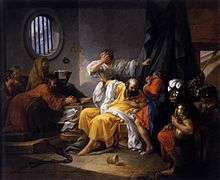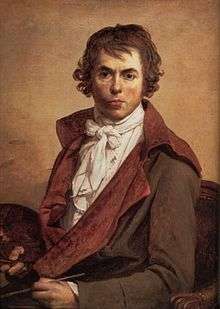The Death of Socrates
 | |
| Artist | Jacques-Louis David |
|---|---|
| Year | 1787 |
| Medium | Oil on canvas |
| Dimensions | 129.5 cm × 196.2 cm (51.0 in × 77.2 in) |
| Location | Metropolitan Museum of Art, New York |
The Death of Socrates (French: La Mort de Socrate) is an oil on canvas painted by French painter Jacques-Louis David in 1787. The painting focuses on a classical subject like many of his works from that decade, in this case the story of the execution of Socrates as told by Plato in his Phaedo.[1][2] In this story, Socrates has been convicted of corrupting the youth of Athens and introducing strange gods, and has been sentenced to die by drinking poison hemlock. Socrates uses his death as a final lesson for his pupils rather than fleeing when the opportunity arises, and faces it calmly.[1] The Phaedo depicts the death of Socrates and is also Plato's fourth and last dialogue to detail the philosopher's final days, which is also detailed in Euthyphro, Apology, and Crito.
In the painting, an old man in a white robe sits upright on a bed, one hand extended over a cup, the other gesturing in the air. He is surrounded by other men of varying ages, most showing emotional distress, unlike the stoic old man. The young man handing him the cup looks the other way, with his face in his free hand. Another young man clutches the thigh of the old man. An elderly man sits at the end of the bed, slumped over and looking in his lap. To the left, other men are seen through an arch set in the background wall.
Painting
|
|
Although he consulted Father Adry, a scholar on the subject, David's depiction of Socrates death contains many historical inaccuracies. For simplicity, he removed many characters originally described in the dialogues of Plato. However, he included Apollodorus, the man leaning against the wall just within the arch, even though he is said to have been sent away by Socrates for displaying too much grief. David also misrepresented the ages of many of the pupils of Socrates, including Plato. Plato would have been a young man at the time of Socrates's death, but in this painting he is the old man sitting at the foot of the bed. Even the face of Socrates is much more idealized than the classical bust that is typically used as a reference portrait of Socrates.[1]
David uses color to highlight the emotion in this painting. The shades of red are more muted on the edges of the painting and become more vibrant in the center, culminating in the dark red robe of the man holding the cup of poison, generally taken as offering the cup to Socrates rather than receiving it after Socrates had consumed its contents. The only two serene men, Socrates and Plato, are garbed in a contrasting bluish-white. The more muted color scheme of this painting may be a response to critics of David's Oath of the Horatii, who called his colors "garish".[1]
David signed this painting in two places; he put his full signature under Crito, the young man clutching Socrates's thigh, and his initials under Plato. David's signature placement often had symbolic meaning – for example, in his painting of Stanisław Kostka Potocki, David signed in the collar of the dog that is barking at the sitter. In Death of Socrates, his signatures also have meaning. His initials under Plato are a reference to the fact that the story comes from Plato, a thanks for the inspiration. His fuller signature under Crito means that this is the character whom the artist identifies most with. This may be a reference for Crito’s position in the composition – clutching Socrates's thigh. In this way, David would be seen as a man who likewise clutches at the morals and values that Socrates represents.[2]
There is some controversy as to the origins of the painting. Vidal states that "the younger of Trudaine de Montigny's two sons commissioned David's Death of Socrates in 1786",[3] but Bordes says that "the drawing for Socrates…bears the unexpected date of 1782." However, it is possible that the commission in 1786 was for a painting that David had already conceived as early as 1782, and Bordes does acknowledge that the date is an addition to the drawing.[4] Regardless of when it was originally conceived, the painting was completed in 1787, in Paris.
It was during David's first trip to Rome that he began to study the depiction of funerary scenes and to draw many examples. Many of David’s major works stem from these funerary drawings.[5] In this painting, David examines a philosopher's approach to death. Socrates is stoic and calm because he sees death as a separate, actual realm, a different state of being from life but not an end to being.[6] In fact, in Phaedo, Socrates seems more concerned with how Crito will handle his death than with his own well-being.[7] In the painting, Socrates's gesture shows us that he is still teaching, even in the moment before his death. It is said that this gesture was inspired by the poet André Chénier.[3]
Another painting depicting the event was done by the Italian artist Giambettino Cignaroli. Cignaroli's work shows Socrates already dead, surrounded by his anguished followers.[8]

Yet another depiction of Socrates' death was done by the French artist Jacques-Philippe-Joseph de Saint-Quentin. The work, currently housed at the École Nationale Supérieure des Beaux-Arts in Paris, France, dates to circa 1738.[9]
Notes
- 1 2 3 4 De Nanteuil, Jacques-Louis David,64.
- 1 2 Lajer-Burcharth, Necklines,57.
- 1 2 Vidal, "David among the Moderns", 598.
- ↑ Bordes, "David", 154.
- ↑ De Caso, "Jacques-Louis David and the Style 'All' antica'", 686.
- ↑ Maleuvre, "David Painting Death", 25.
- ↑ Plato, Phaedo, 127.
- ↑ "The Death of Socrates - Giambettino Cignaroli Gallery". Lib-Art.com. Retrieved August 3, 2011.
- ↑ "The Death of Socrates by Jacques-Philippe-Joseph de Saint-Quentin". friends-of-art.net. Retrieved August 3, 2011.
References
- Bordes, Philippe. “David: Paris and Versailles.” The Burlington Magazine' 132, no. 1043 (Feb. 1990): 154–156.
- De Caso, Jacques. “Jacques-Louis David and the Style 'All' antica'.” The Burlington Magazine 114, no. 835(Oct.1972):686-690.
- De Nanteuil, Luc. Jacques-Louis David. New York: Harry N. Abrams, Inc., 1990.
- Lajer-Burcharth, Ewa. Necklines: The Art of Jacques-Louis David after the Terror. New Haven: Yale, 1999.
- Maleuvre, Didier. “David Painting Death.” Diacritics' 30, no. 3 (Fall 200): 1–27.
- Plato, Eva T. H. Brann, Peter Kalkavage, Eric Salem . Phaedo. Focus Publishing/R. Pullins: Bloomington,1998.
- Vidal, Mary. “David among the Moderns: Art, Science, and the Lavoisiers.” Journal of the History of Ideas56, no. 4 (Oct. 1995):595–623.
External links
| Wikimedia Commons has media related to The Death of Socrates (Jacques-Louis David). |
- Europe in the age of enlightenment and revolution, a catalog from The Metropolitan Museum of Art Libraries (fully available online as PDF), which contains material on this painting (see index)
- The Death of Socrates on Google Art Project
